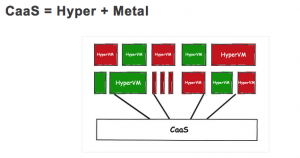Docker’s popularity and usefulness in cloud systems architectures is evident, having won over countless developers. Yet, it’s not a replacement for mature, proven and security-hardened virtualization technologies that support many of the world’s largest clouds in production.
So, while developers clearly want to take advantage of container technology to easily package applications, they also need a seamless migration path to their existing virtual infrastructure. That’s where our new partner Hyper announced today comes into play.
Hyper, a Chinese-based company with a new open source project by the same name, allows developers to run Docker images with Xen Project virtualization, version 4.5 or later. Download available here.
“Hyper offers the best of both worlds — VMs and containers,†said Xu Wang, Co-Founder at Hyper. “Our technology allows enterprises to leverage any mature, implemented virtualization infrastructure and eliminate unwanted complexity and also take advantage of container technology to easily package applications. We are partnering with Xen more closely to help developers get more out of their hypervisor, while also enjoying the benefits of container technology.â€
To learn more, be sure to check out the presentation “Hyper: Make VM Run Like Containersâ€Â at Xen Project Developer Summit, Aug. 17-18. You’ll also find them at The Linux Foundation’s new ContainerCon event, as a bronze sponsor.
Hyper Enables the Next-Generation Container-as-a-Service
To eliminate these problems, Hyper uses virtualization to achieve hardware-enforced isolation. Unlike a VM + container approach, Hyper does not employ a GuestOS in the VM instance. Instead a HyperKernel, a customized Linux Kernel which includes Docker functionality, is loaded to host the Docker images. Hyper guests also does not require any Linux Container technology: in other words in Hyper guests do not require LXC, cgroups, namespace and Docker daemon to run; they only require MOUNT namespace to support pods of Docker images.

To learn more about this minimalist approach, which also offers sub-second boot, rapid ROI, enhanced security, minimal resource footprint and overheads and more, check out these additional resources:
- Details on Hyper’s Xen Project Developer Summit presentation: http://xendevsummit2015.sched.org/event/add4ce535fb8c83963177690e1f602ce
- Getting Started with Hyper:Â https://docs.hyper.sh/get_started/install.html
- How Hyper Works:Â https://docs.hyper.sh/how_it_works.html
- Why Hyper:Â https://docs.hyper.sh/why_hyper.html
- Docker, Hyper and the end of Guest OS:Â https://hyper.sh/blog/post/2015/06/29/docker-hyper-and-the-end-of-guest-os.html
Continuous innovation is the lifeblood of any project, and Xen Project is fortunate to have an extremely active and growing community. Partners like Hyper allow Xen Project to stay one step ahead of the industry with security, performance and scalability as cloud and computing infrastructures evolve.
